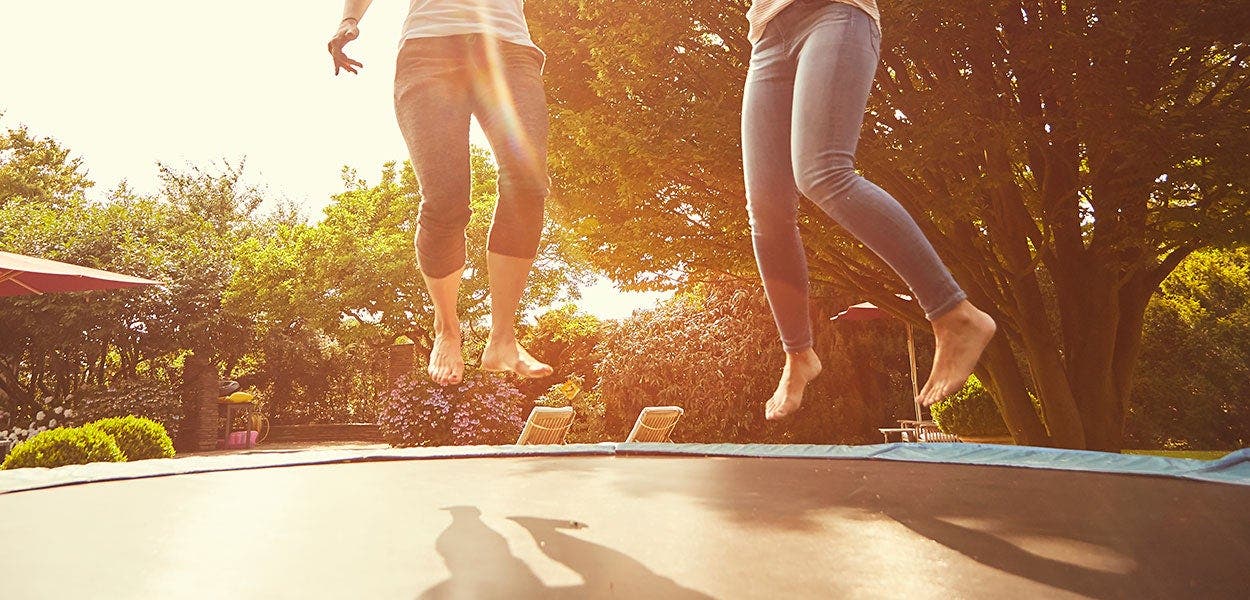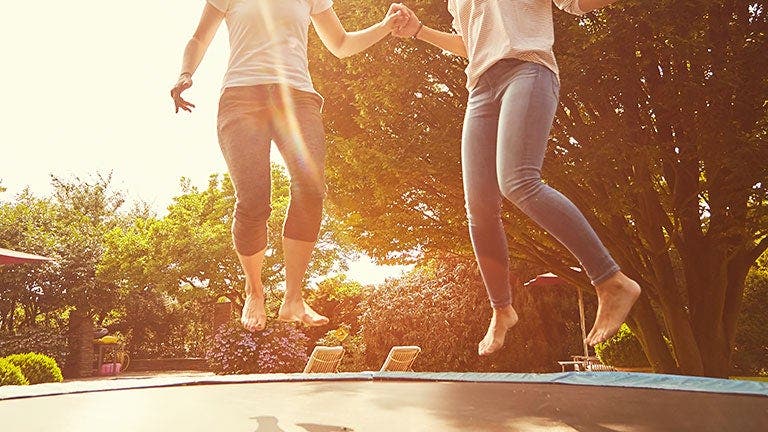Bounce your way fit


Want to have a blast while slimming down and shaping up? Then put rebounding on your radar. This low-impact activity using a mini-trampoline is great for anybody who has joint issues or just wants to challenge their body differently.
Don’t think you have to belong to a swanky gym to do rebounding - all you need is a trampoline. Although you can find classes at health clubs, you can also rebound at home, as you’ll see in the following guide, which gives you the scoop on how to jump into this hot trend. In the end, you’ll swear sweating has never been more fun!
At home
Surprisingly, rebounding at home doesn’t require a ton of space. For starters, clear a 10-foot square area, which should give you enough space for a rebounder and room to move around it, says JB Berns, creator of the Urban Rebounder and its fitness programs.
You’ll also need clearance above your head — but not as much as you might think. Unlike trampolines, where your goal is to jump high, rebounding is all about bouncing strong into the mat. “You’re focusing more on deceleration instead of acceleration upward which means you’re only going an inch or two off the mat,” Berns says. A ceiling height of seven feet should do the trick.
Do a little homework - don't just buy the first rebounder you see. Your most important concern? “Make sure the rebounder can accommodate your weight,” says Ashley Borden, fitness and lifestyle consultant in Los Angeles (specifics are listed on the packaging). Choosing a mini-trampoline with a color ring around the edge will aid your peripheral vision when jumping.
Another consideration? Although you can purchase DVDs separately, it’s best if you can find a mini-trampoline that comes with a DVD. “The DVD will guide you through steps for that specific rebounder, since the exercises differ depending on the features of the mini-trampoline,” says Franci Cohen, personal trainer and exercise physiologist and CEO of Fuel Fitness in New York City, who’s taught rebounding classes for more than 15 years.
Finally, get your jumping attire in order. Because you’ll be bouncing, a supportive sports bra is key. Next, don regular exercise apparel and shoes, preferably cross trainers for support, says Berns, who notes that going barefoot while doing this can strengthen foot muscles.
Ready to get started? Here are six options for an at-home rebounder:
-
The bargain (ProForm Exercise Trampoline, $39.99, target.com): Inexpensive folding trampoline that can support up to 250 pounds.
-
Raising the bar (GAIAM Mini-Trampoline Workout System, $99, gaiam.com): Includes a removable stability bar and 35-minute workout DVD. Supports up to 250 pounds.
-
Leg lifter (Elevated Urban Rebounder, $119.95; urbanrebounding.com): Features a removable stability bar, option to elevate the legs, and DVD with three workouts. Supports up to 300 pounds.
-
The portable pro (JumpSport Model 230f, $249, jumpsport.com): Folding trampoline so you can take your workout wherever you want. Comes with a workout DVD for beginners. Supports up to 250 pounds.
-
Firm fit (Non-folding Hard-Bounce Rebounder, $359, needak-rebounders.com): Comes with two free DVDs; its firmer surface is designed for people over 300 pounds.
- The total package (Bellicon Rebounder, starting at $499, bellicon-usa.com): Includes a DVD and offers free workouts on its website. Choose the ultra bungee strength for up to 440 pounds of support.
At gyms and health clubs
If you don’t feel like rebounding alone, numerous health clubs offer rebounding classes. For instance, you can find Urban Rebounding classes at more than 5,000 gyms in the United States and Canada.
While cardio is the main focus of these classes, you’ll also find some that develop strength and flexibility and incorporate other activities like plyometrics (jumping exercises which focus on increasing speed and power), interval training, kickboxing, Pilates and yoga — sometimes, more than one of these in a workout! Classes vary in length but generally last 30 to 60 minutes.
Bounce at the park
Thrill seekers have another option, namely trampoline parks which also offer fitness classes. Unlike rebounding, these 45 to 60-minute classes use huge trampolines and encourage you to jump as high as you can. Sky Zone Indoor Trampoline Park, which has over 70 locations nationwide, for instance, offers two classes. There’s SkyRobics, which incorporates calisthenics, core exercises and strength training, while SkyFitness concentrates more on endurance and strength. Or try bootcamp style classes at Flight Trampoline Park, which has locations in four states.
That’s why you’ll need to pay closer attention to what you wear. Because you’re flying in the air more, sport form-fitting duds versus loose clothing, says Rhonda See, fitness coach and owner of Sky Zone Trampoline Park in Buffalo and Rochester, NY. On your feet, wear special socks that help you grip the trampoline better (you can buy them at the park for a few bucks), minimalist shoes or go barefoot.
